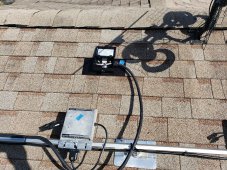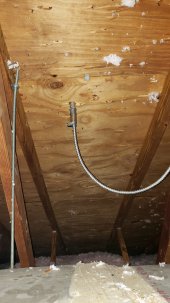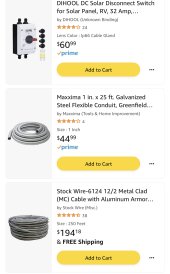I’m interpreting guidelines that DC PV cable from panel array should be run in metal conduit or flexible metal conduit when inside the home/attic/basement.
The following is my plan. Please point out any errors in my interpretation of guidelines and offer any suggestions.
Thank you.
Six 400W panels on south side roof in a series then two 12AWG PV cables + array mount 6gauge copper grounding wire initially through 3/4 inch PVC conduit through the roof….then junction to 3/4 inch flexible metal conduit in the attic (copper grounding wire splits off at the junction to house ground across the attic then down the garage wall)…The DC PV cables then run out of house via soffit/eaves inside flexible metal conduit on the north side of the house to DC disconnect box then short run 3/4 inch PVC conduit to 20 Amp circuit breaker then short run of 3/4 inch PVC conduit to EG4 12K mini split outdoor unit.
The following is my plan. Please point out any errors in my interpretation of guidelines and offer any suggestions.
Thank you.
Six 400W panels on south side roof in a series then two 12AWG PV cables + array mount 6gauge copper grounding wire initially through 3/4 inch PVC conduit through the roof….then junction to 3/4 inch flexible metal conduit in the attic (copper grounding wire splits off at the junction to house ground across the attic then down the garage wall)…The DC PV cables then run out of house via soffit/eaves inside flexible metal conduit on the north side of the house to DC disconnect box then short run 3/4 inch PVC conduit to 20 Amp circuit breaker then short run of 3/4 inch PVC conduit to EG4 12K mini split outdoor unit.






